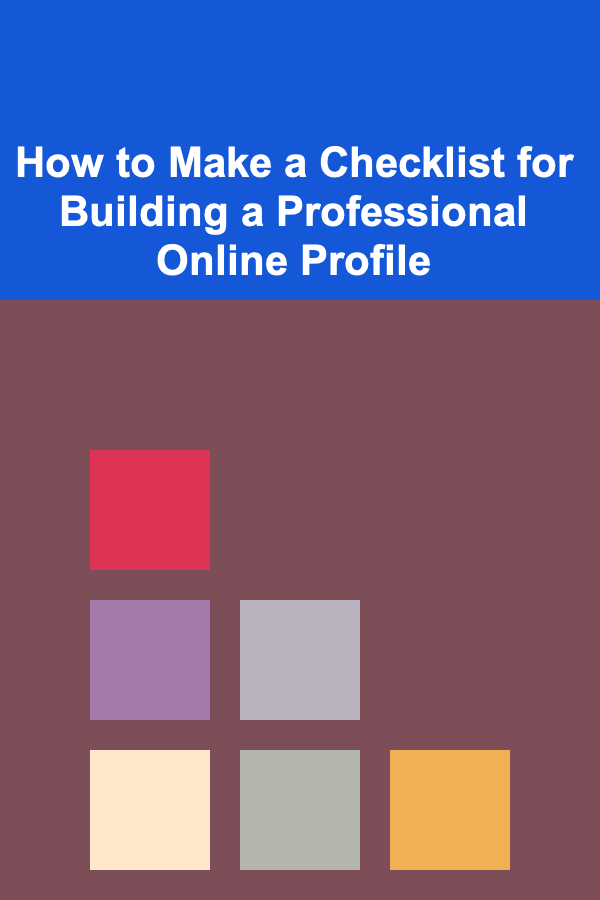
How to Make a Checklist for Building a Professional Online Profile
ebook include PDF & Audio bundle (Micro Guide)
$12.99$8.99
Limited Time Offer! Order within the next:

In today's digital era, building a strong professional online profile is crucial. Whether you're a job seeker, freelancer, or entrepreneur, a well-crafted online presence can make a significant difference in how you're perceived in the professional world. This checklist will guide you through the essential elements and strategies to create a compelling online profile that not only highlights your skills but also positions you as a credible and trustworthy professional.
Choose the Right Platforms
Before diving into creating content for your online profile, it's important to identify which platforms are most relevant to your industry and professional goals. Here's a breakdown of common platforms and their best uses:
- LinkedIn: The go-to professional networking site. LinkedIn is ideal for building a career-oriented profile, connecting with other professionals, and applying for jobs. It's also a valuable tool for showcasing your expertise through articles and recommendations.
- Personal Website or Portfolio: Having your own website can be a strong signal of professionalism, particularly for creatives like graphic designers, writers, or web developers. This platform allows for complete control over your brand, with the option to display your work, share your biography, and even host a blog.
- Twitter: While Twitter is often used for casual social interactions, it can also be an excellent tool for thought leadership, networking, and sharing industry insights. Many professionals use Twitter to connect with others in their field and engage in real-time conversations.
- GitHub (for tech professionals): If you're a developer or involved in software engineering, GitHub is crucial for displaying your coding skills, contributing to open-source projects, and engaging with the broader programming community.
- Behance/Dribbble (for creatives): If you're a designer, these platforms provide a dedicated space to showcase your work and connect with other creative professionals.
- Industry-Specific Networks: Depending on your profession, you may want to be part of specialized networks or forums. These platforms often offer more niche interactions and can help you establish authority in your field.
Actionable Tip:
- Research and select the platform that best matches your goals. LinkedIn and a personal website are generally good starting points for most professionals. However, don't overlook niche platforms if they align with your career goals.
Craft a Compelling Profile Headline
Your profile headline is often the first thing others will see when they encounter your online presence. It's essential to make it attention-grabbing, yet informative.
- Clear and Concise: Your headline should immediately communicate what you do. If you're a freelance writer, for example, a headline like "Freelance Writer Specializing in Tech & Lifestyle Content" is far more effective than just "Freelance Writer."
- Highlight Your Unique Selling Point (USP): Think about what sets you apart from others in your field. Are you known for your creativity, analytical skills, or leadership? Incorporating your USP will help make your profile stand out.
- Avoid Buzzwords: Phrases like "hardworking," "team player," and "dynamic leader" are overused and don't convey much specific information. Be more precise about your skill set and expertise.
Actionable Tip:
- Take a few moments to brainstorm what makes you unique in your field. Then, use this information to craft a headline that highlights your value proposition.
Write an Engaging and Authentic Bio
Your bio is your opportunity to tell your professional story. While your headline grabs attention, your bio needs to establish credibility and allow others to connect with you on a deeper level. Here's how to write an effective bio:
- Introduce Yourself Clearly: Start by introducing your current role or profession. Mention your key areas of expertise and what you're passionate about.
- Highlight Key Achievements: Share accomplishments that demonstrate your abilities. Instead of simply stating your job title, describe the results you've achieved, like increasing revenue, driving engagement, or launching a successful project.
- Be Authentic: It's tempting to use overly formal or jargon-heavy language in professional bios, but authenticity is key. Let your personality shine through. Be genuine, and don't be afraid to share what excites you about your work.
- Add a Personal Touch: If applicable, add a brief personal detail to make your bio more relatable. A mention of a hobby or interest outside of work (that ties back to your professional life) can help humanize you.
Actionable Tip:
- Write your bio in the third person if you're creating a personal website or portfolio. If it's a LinkedIn profile, first-person writing is usually preferred for a more conversational tone.
Showcase Your Skills and Expertise
Whether through certifications, a portfolio, or simple lists of your expertise, your skills are crucial to your professional online profile. But how can you best present them?
- List Relevant Skills: On platforms like LinkedIn, you can list your skills in a specific section. Be sure to include the most relevant and in-demand skills for your profession. If possible, back up your skills with examples or measurable results.
- Portfolio: For creative professionals, showcasing work in a visual format is key. Include high-quality images or case studies of your work. For writers, having samples of published articles or blog posts can be invaluable.
- Recommendations: On platforms like LinkedIn, you can request recommendations from colleagues, clients, or employers. These testimonials serve as social proof, validating your skills and work ethic.
- Certifications and Awards: Include any relevant certifications, degrees, or awards you've received. This helps build trust and demonstrates your commitment to professional development.
Actionable Tip:
- Regularly update your skills section to reflect your current abilities. Highlight your most impressive accomplishments, and be sure to collect recommendations periodically to keep your profile fresh.
Use Professional, High-Quality Photos
Your profile picture is often the first visual impression you make online, so it's crucial to ensure that it's professional and appropriate for your industry.
- Quality Matters: Avoid low-resolution or overly casual images. Choose a high-quality photo where you appear approachable and professional.
- Dress for Your Industry: Your attire should be suitable for the type of work you do. For example, a formal photo might be appropriate for someone in finance or law, while a more casual shot could work for creative fields like design or tech.
- Background and Lighting: Make sure the background is clean and simple, with good lighting. Avoid distractions or clutter behind you.
- Consistency Across Platforms: Use the same profile photo across different platforms. This helps create consistency and strengthens your brand.
Actionable Tip:
- Hire a professional photographer if possible, or use a smartphone with a high-quality camera and good natural lighting. Make sure your face is clearly visible, and avoid using overly stylized or edited images.
Optimize for SEO
Optimizing your online profile for search engines can make it easier for people to find you when searching for professionals in your field. Here's how to optimize your profile:
- Use Keywords: Identify relevant keywords that people might use to search for your services or expertise. Include these keywords in your profile headline, bio, and work experience sections.
- Link to Your Website: If you have a personal website or portfolio, include a link in your profile. This not only helps with SEO but also directs visitors to more in-depth information about you.
- Share Content Regularly: On platforms like LinkedIn, sharing articles, posts, and updates regularly can improve your profile's visibility. It signals to both the platform and search engines that your account is active and authoritative.
Actionable Tip:
- Use tools like Google Keyword Planner or Ubersuggest to identify relevant keywords. Then, naturally incorporate those keywords into your profile's content.
Engage with Your Network
Building a professional online profile is not a one-time task. You need to actively engage with your network to maintain visibility and build credibility.
- Comment and Share: Participate in discussions and comment on posts in your industry. Share relevant content and insights to showcase your knowledge.
- Join Groups and Communities: Many platforms, like LinkedIn and Facebook, have industry-specific groups where professionals share ideas and opportunities. Actively participating can increase your visibility.
- Reach Out: Don't hesitate to reach out to others in your field. Whether it's for networking, advice, or collaboration, direct messages or connection requests can help you expand your network.
Actionable Tip:
- Set aside time each week to engage with posts and articles in your industry. Respond to comments, participate in discussions, and make new connections.
Keep It Updated
Your online profile should never be static. As your career evolves, so should your profile. Regularly update it with new achievements, projects, and skills to reflect your professional growth.
- New Skills and Certifications: Every time you gain a new skill or certification, be sure to update your profile to include it.
- Current Projects: If you're working on any new projects or have noteworthy accomplishments, update your profile accordingly.
- New Job or Role: Whenever you change jobs or take on new responsibilities, reflect this on your profile to keep it accurate.
Actionable Tip:
- Set a reminder to review and update your profile every 3 to 6 months to ensure that it always reflects your latest achievements and career developments.
By following this checklist, you can create a comprehensive, professional online profile that sets you apart in the digital world. The key to building an effective online presence is consistency---both in terms of the platforms you use and the quality of the content you share. Invest time in making your online profile professional, authentic, and engaging, and it will become a powerful tool for career growth and networking.
Other Products

Earning Money through Deep Learning: Opportunities for Entrepreneurs
Read More
How to Build Credit When You're Just Starting
Read More
How to Organize Your Bathroom with Minimalistic Storage Solutions
Read More
How to Organize Your Car for Quick Errands
Read More
How to Organize Your Hobby Supplies for Creativity
Read More